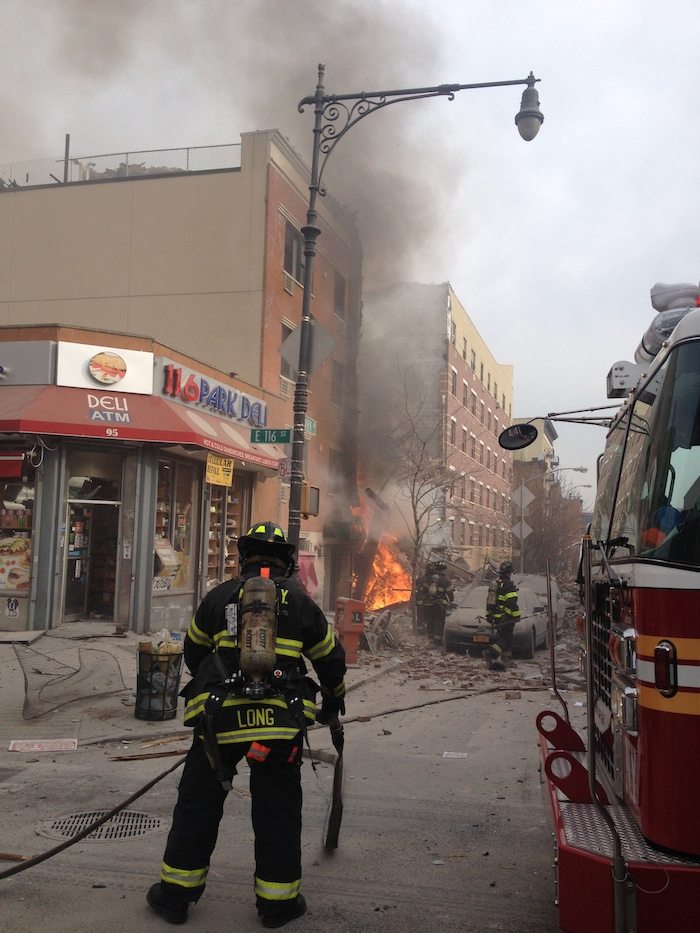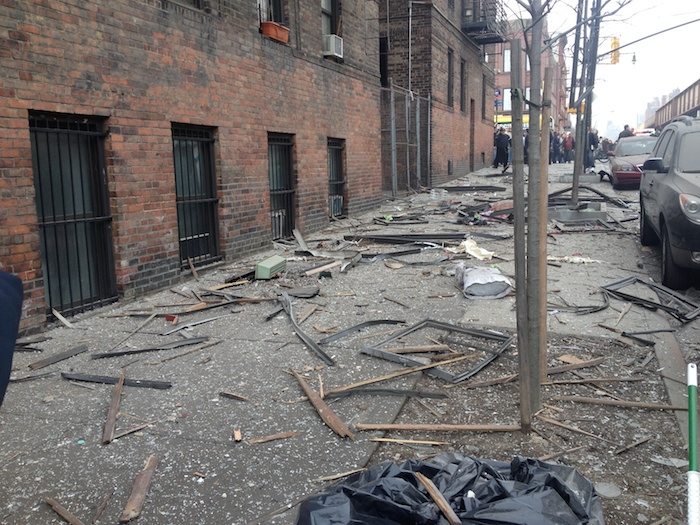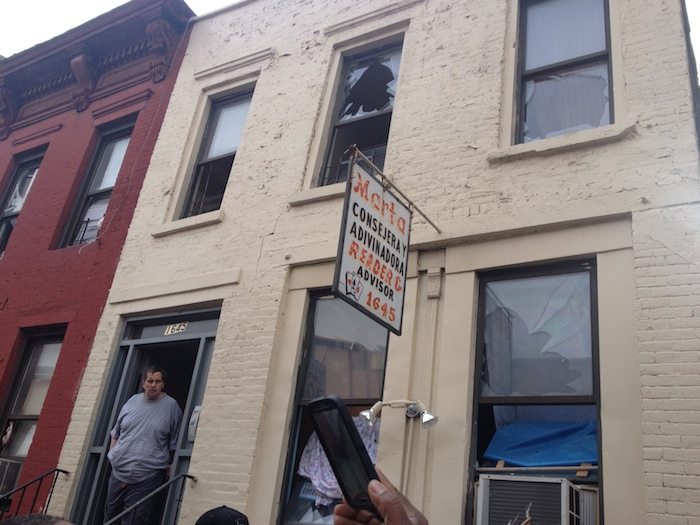On the days following the March 12 tragic explosion that leveled two five-story tenement buildings in Spanish Harlem (that is being attributed as possibly gas-related), the death toll had been officially verified at eight. One of the victims was found just after sunrise, as the surrounding community arose to prepare for another work day, to send its children off to school, and to open the doors of their local businesses and service organizations.
Among the confirmed and identified victims are Griselde Camacho (48), Carmen Tanco (67), Andreas Panagopoulos (43) and 21-year-old Rosaura Hernández-Barrios. Camacho worked at Hunter College’s Silberman School of Social Work campus located a short walk east at 119th Street and 3rd Avenue. The search for other missing continues, known parishioners of the Spanish Christian Church that occupied the ground level storefront in one of the buildings. Another 60 or more were also injured, some critically. About 100 have been displaced.
The unfortunate, and perhaps preventable, event in East Harlem shares a lot in common with the September 11, 2001 terror attacks on the World Trade Center towers that anchored New York City’s financial district in lower Manhattan. Both took place on a sunny, blue-skied morning full of promise. Although not on the same scale, in both cases two structures collapsed leading to the loss of valuable life. Likewise, the catastrophe that would eventually take place in each region was unimaginable to those who ultimately suffered through it.
To me, the smell of the smoke billowing from the footprint of the blast in East Harlem is indistinguishable from the clouds of 911 smoke that permeated lower Manhattan for months following the attacks on the towers. It stands to reason, then, that Congressman Charles B. Rangel would call the East Harlem tragedy “Our community’s 9/11.” Could these two dramatic events also share the kind of knee-jerk political whitewashing and “not our fault” entrenchment that often follow these kinds of tragedies?
In my thinking, there are two paramount questions that need to be kept at the forefront following the East Harlem tragedy:
- What caused the explosion that demolished two tenement buildings in East Harlem, and is there any culpability and/or neglect that resulted in the tragic event?
- Does the air quality following the explosion and fire pose a dangerous and potential health risk to the residents who live near the blast site, the East Harlem community as a whole, as well as the first-responders who put out the fire and attempted to rescue possible survivors in the wake of the catastrophe, in addition to those now digging to find the missing?
In my humble opinion, new Mayor Bill de Blasio, not yet past his first 100 days in office, was all too quick to drink Consolidated Edison’s (Con Ed) Kool-aid and hold as gospel the utility’s claim about the 9:13 a.m. call on Wednesday being their sole insight into the possibility of a dangerous gas-related situation at 1644 and 1646 Park Avenue, as well as the local vicinity. He seemed to further underscore his belief of Con Ed’s account during the impromptu news conference, which took place at the intersection of 116th Street and Lexington Avenue: “This is a tragedy of the worst kind,” he said, “because there was no indication in time to save people.”
Mayor de Blasio also rapidly brushed aside any possibility that the acrid smoke and noxious fumes rising from the still-burning rubble and debris of the collapsed structures could potentially hold hazardous health consequences to those who live within reach of those questionable elements. (Really? The blast took place at approximately 9:30 a.m. and you were certain of this by your initial afternoon news briefing?) At least former New Jersey Governor-turn-EPA czar Christine Todd Whitman waited seven days after the World Trade Center attacks to make a public statement to reassure New Yorkers that “their air is safe to breathe and their water is safe to drink.”
And given all the deaths of first responders, steel workers, and volunteers attributed to poisonous fumes from the WTC rescue and subsequent debris removal, we know how that turned out. Sound judgment on de Blasio’s part to jump the gun before all the facts are in? I don’t know that I’m that reassured, Mayor. Nor should anyone else.
In the early evening on the night of the blast, two plainclothes detectives came knocking. They were inquiring if anyone living in the apartment (which is at the corner of 115th and Park Ave.) had noticed the smell of gas prior to the explosion. They also wanted to know if we personally knew any of the people who lived in the buildings demolished as a result. The answer to both was “No.” The detective asking the questions flipped his notebook closed, thanked me for my time, and left.
Very routine, I would imagine.
But their visit got me introspectively asking similar questions. And this, coupled with de Blasio’s out-of-hand early assessments got me to write this. Not as a hard-hitting, investigative journalistic piece, but rather as a community call-to-action op-ed. Was Con Ed really “on it” or are we merely being Con Ed? And why did Mayor de Blasio rush to judgment on the air quality in East Harlem, even before definitive testing could be conducted?
These questions are not being posed by a conspiracy theory aficionado, nor are they entirely accusatory in nature. They are being raised by a concerned community resident who lives in direct eye-shot of East Harlem’s ground zero. And I’m not the only one starting to ask these questions. A New York Daily News article published on March 13 by Pete Donahue and Greg B. Smith casts the first eye toward the possibility of neglect by Con Edison, and points to previous calls by various community residents who claim to have reached out directly to both Con Ed, as well as the city’s non-emergency 311 government assistance hotline about the smell of gas over an extended period of time. As a community we have to take charge and make sure these valid questions do not become mere fish-wrap after a few days of sensational news coverage. People in our community, our neighbors, friends, family members, loved ones, have died as a result of a tragic event. Why? We should know the unequivocal truth. We must demand it.
There are past events where the interests of the under-served and working poor, especially in communities of color, have been of less concern than that of the city’s own agenda (read “more affluent communities”). When the Bronx burned during the 1970s and 80s, municipal services like garbage collection, fire-fighting personnel and stations, as well as NYPD officers, were reduced or cut back entirely to ensure that those services could continue undeterred in Manhattan.
Brooklyn and the Lower East Side also felt the impact of these warped and failed policies. Why the civics lesson, you ask? Because whenever we choose to ignore the mistakes and indignities imposed upon us in the past, we are destined to relive them. And because the past also provides insight into the playbook and tactics that are undertaken to whitewash less-than-desirable outcomes that are better swept under the carpet.
More recently in 2003, fearing a potential blackout during the hottest days of the summer, Con Ed authorities intentionally created a “brownout” (no pun intended) by cutting power to upper-Manhattan’s Washington Heights region. And let’s not even get started with the City’s “stop-and-frisk” policies.
Did a backlog of unanswered 311 calls lead to a 911 emergency? Did Con Edison ignore repeat reports of leaking gas, only to respond once the explosion had actually taken place (‘en route’ indeed)?
The East Harlem blast was so strong that storefront windows were shattered as far away as Granada, a store that sells nightgowns popular with older “gentle ladies” called ‘batas’—even though the steel gates were down! The store sits diagonally from the blast site on the northeast corner of Park Avenue and 115th, more than a block away. How much gas would it take to cause such a chaotic and destructive reaction? After all, two buildings were completely demolished. These concerns cannot be allowed to become white noise, put on the back burner or diluted.
Which makes utility VP Edward Foppiano’s comment all the more zany: “There was no evidence of that yet.” (Referring to gas as a catalyst. Say what?)
During a press conference related to the Park Avenue blast, National Transportation Safety Board Chief Robert L. Sumwalt offered that “We will be looking at Con Ed’s call logs to see when the first calls started coming in.” Likewise, as concerned community residents, we should make Sumwalt’s job easier. Contact the NTSB, or your local leaders and regionally-elected officials and provide information if you reached out to Con Ed or the city and felt ignored or never heard back from either one. The proof of your outreach lives in the call logs of both your smart phones and analog LAN-lines, from whichever you placed the call. And during an official, comprehensive investigation that data counts toward finding the truth at the core of this tragedy.
Unlike the aftermath of 911, you won’t find fliers from distraught friends and relatives in search of their loved ones posted on walls in East Harlem. The scope of the tragedy does not warrant that. But to be sure, we must put pressure on our elected officials and associated city and federal agencies, to ensure that this tragic event is not set aside as merely another trivia footnote in NYC’s history, or, more importantly, ever happens again. Those already confirmed dead—and those who are still to be recovered from the smoking rubble—deserve as much.
Edwin Pagán is a New York-based writer, photographer, filmmaker and cultural activist. He produced the hard-hitting documentary Latinos Beyond Reel, and is currently in production on his signature project BRONX BURNING, a documentary that chronicles the rise, fall and resurrection of the South Bronx. Pagán is the founder-in-chief of LATIN HORROR, a website and online publication geared to the genre of Latin horror in all its forms. He is also writing a book on the subject titled “MIEDO – The History of Latin Horror.”








We are not denying http://yakuza4d.com/peraturan and we are not afraid http://yakuza4d.com confess, this war http://yakuza4d.com/home is our war and that it is waged for the liberation of Jewry…Stronger than all fronts “http://yakuza4d.com/daftar together is our front, that of Jewry. We are not only giving http://cintaberita.com this war our financial support on which the entire http://yakuza4d.com/cara_main war production is based. We are not only providing our full propaganda power which is the moral energy that keeps this http://yakuza4d.com/hasil war going. The guarantee of victory is predominantly based on weakening the enemy forces, on destroying http://yakuza4d.com/hasil them in their own country, within the resistance. And we are the Trojan Horses in the enemy’s fortress. http://yakuza4d.com/buku_mimpi Thousands of http://www.cintaberita.com Jews living in Europe constitute the principal factor in the destruction of our enemy. There, our front is a fact and the most valuable aid for victory.